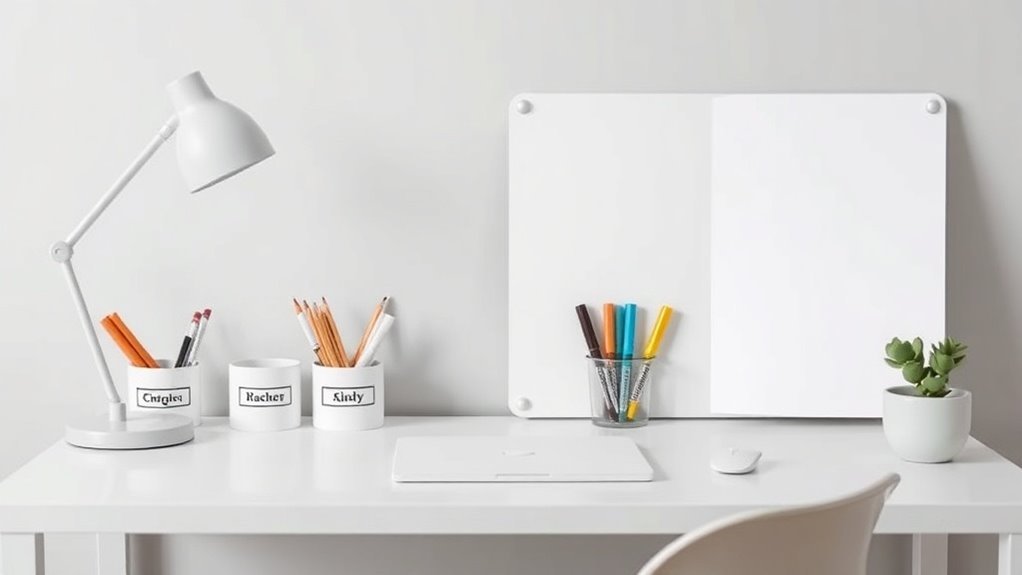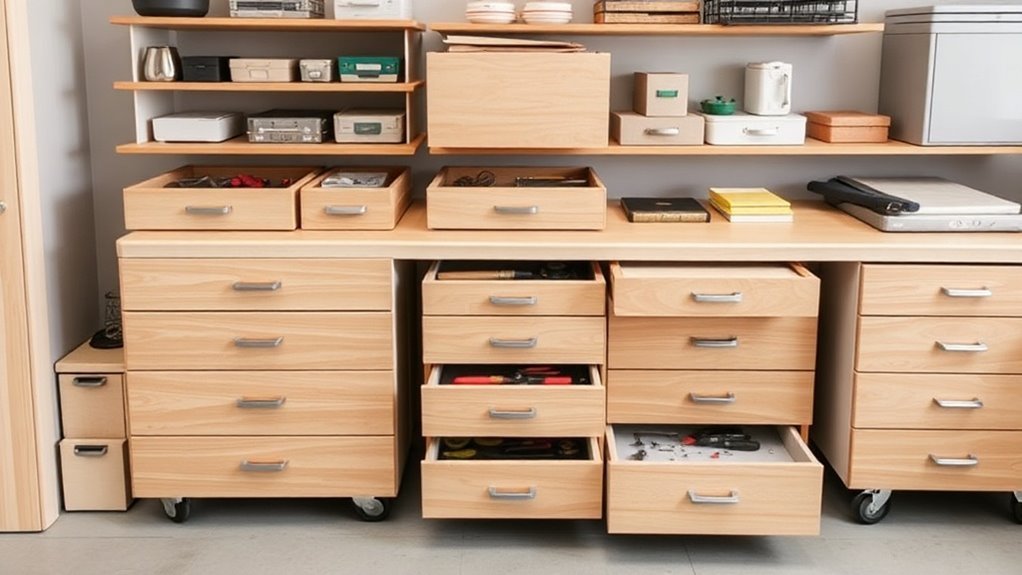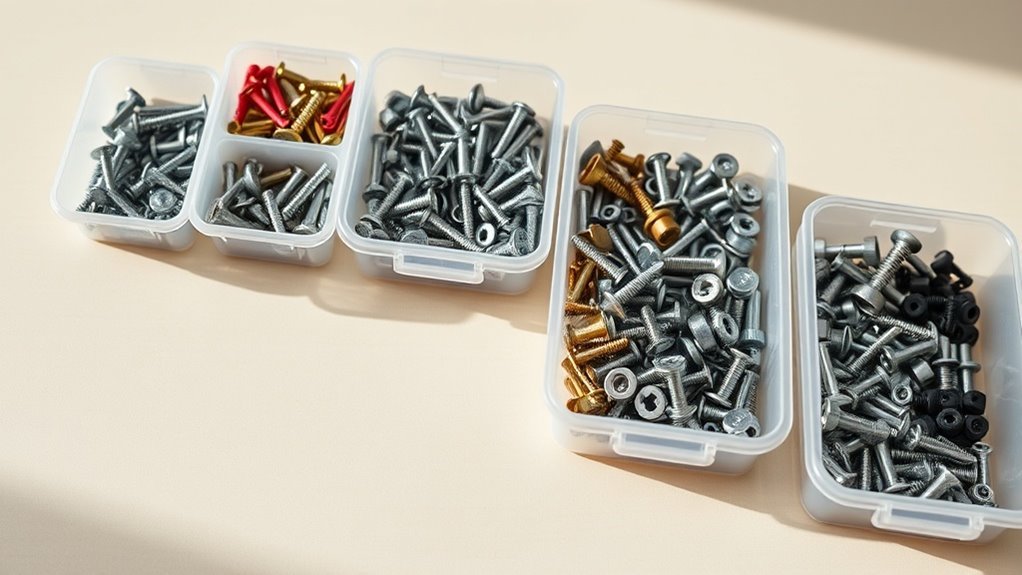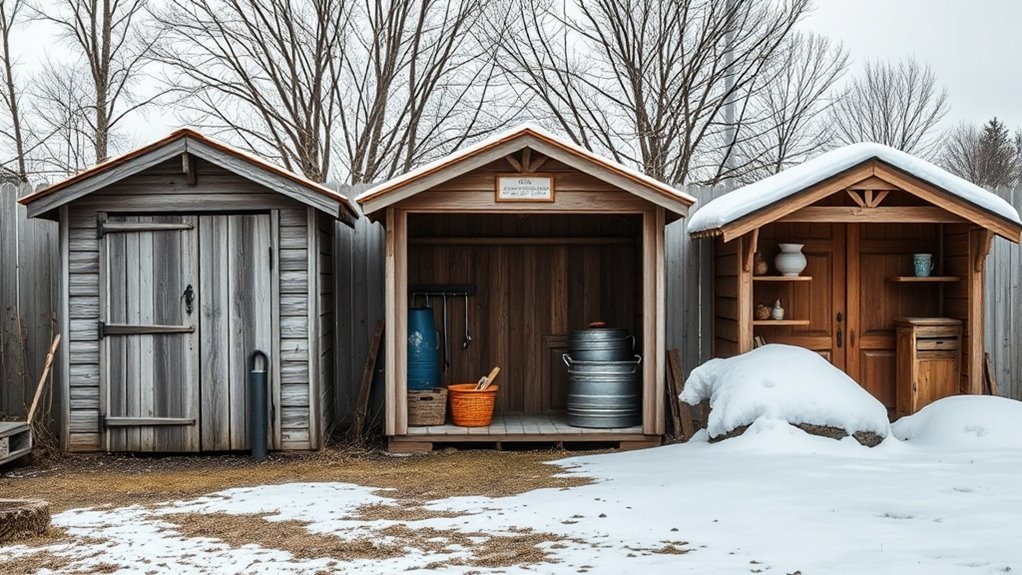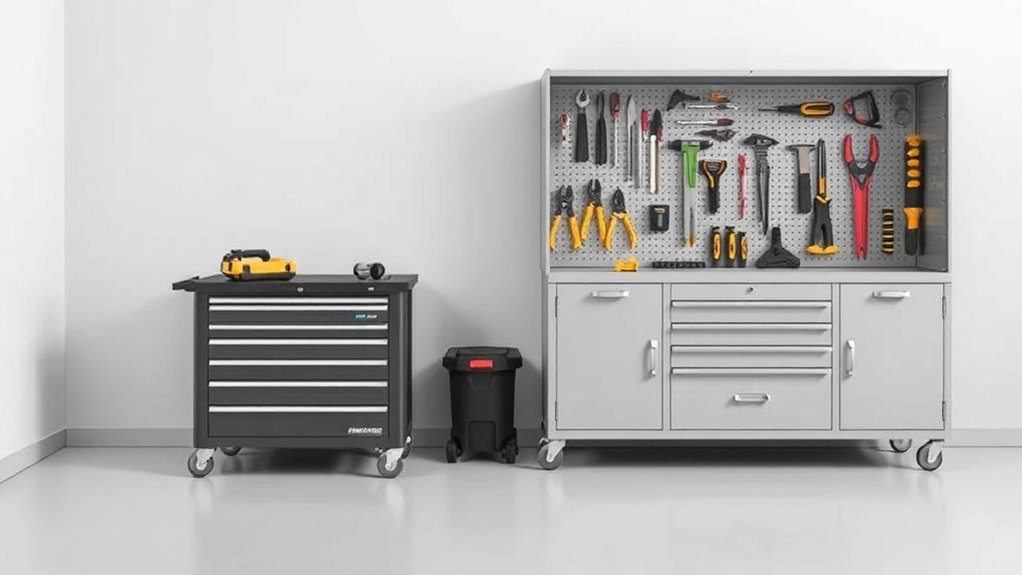Material Comparison: Plastic, Metal, and Fabric Toolboxes
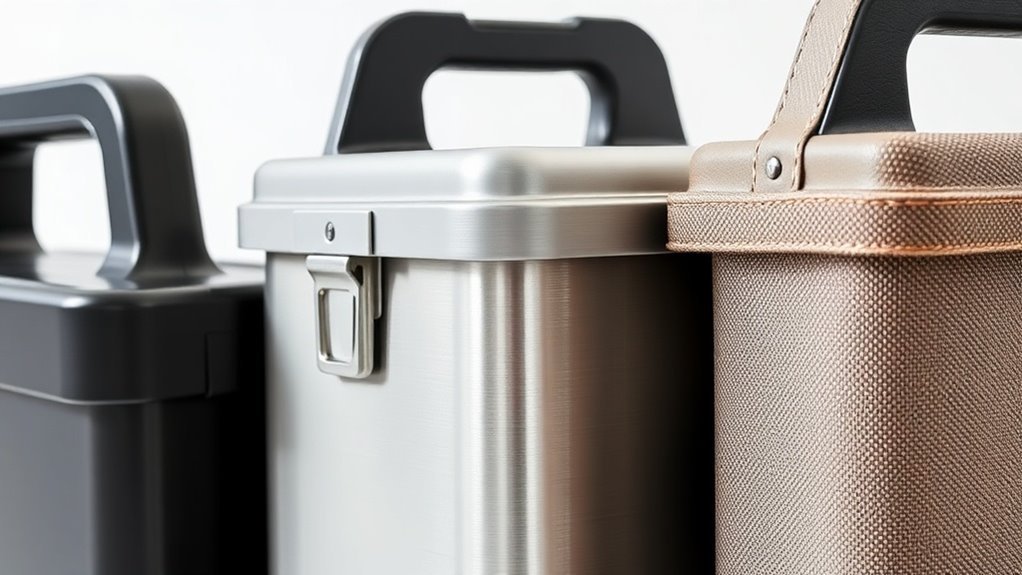
When choosing between plastic, metal, and fabric toolboxes, you need to take into account their unique advantages and drawbacks. Plastic toolboxes are lightweight and cost-effective but may crack under heavy loads. Metal toolboxes offer durability and security but can be heavy and prone to rust. Fabric toolboxes are portable and affordable but lack structure and weather protection. Each material suits different needs, so if you want to explore these options further, there’s more to discover.
Key Takeaways
- Durability: Metal toolboxes excel in durability and weather resistance, while plastic offers moderate durability, and fabric is more prone to wear and tear.
- Weight and Portability: Plastic and fabric toolboxes are lightweight and ideal for transport, whereas metal options are heavier and better for long-term use.
- Price Range: Plastic toolboxes are the most cost-effective, followed by fabric options, with metal toolboxes being the most expensive due to their durability.
- Functionality: Metal toolboxes are best for heavy tools and harsh environments; plastic is good for moderate use, and fabric is ideal for light and portable needs.
- Limitations: Plastic may crack in extreme weather, metal can rust if not maintained, and fabric lacks waterproof features, limiting usage in wet conditions.
Overview of Toolbox Materials
When it comes to toolboxes, material choice plays a crucial role in durability and functionality. You’ll find three primary materials: metal, plastic, and fabric.
Metal toolboxes offer strength and security, making them ideal for heavy equipment. They resist wear and tear but can be heavier and prone to rust if not properly maintained.
Metal toolboxes provide robust security for heavy equipment, though they require maintenance to prevent rust and manage weight.
Plastic toolboxes are lightweight and often resistant to various environmental conditions, providing flexibility in design and color. However, they mightn’t hold up as well under extreme stress.
Finally, fabric toolboxes are portable and usually more accessible; they’re perfect for light tools and easy transport, though they may lack the structure and durability of the other materials.
In addition, selecting quieter tools can enhance the overall efficiency of your workspace by minimizing unnecessary noise during operations.
Each choice has its specific applications, catering to your needs.
Benefits of Plastic Toolboxes
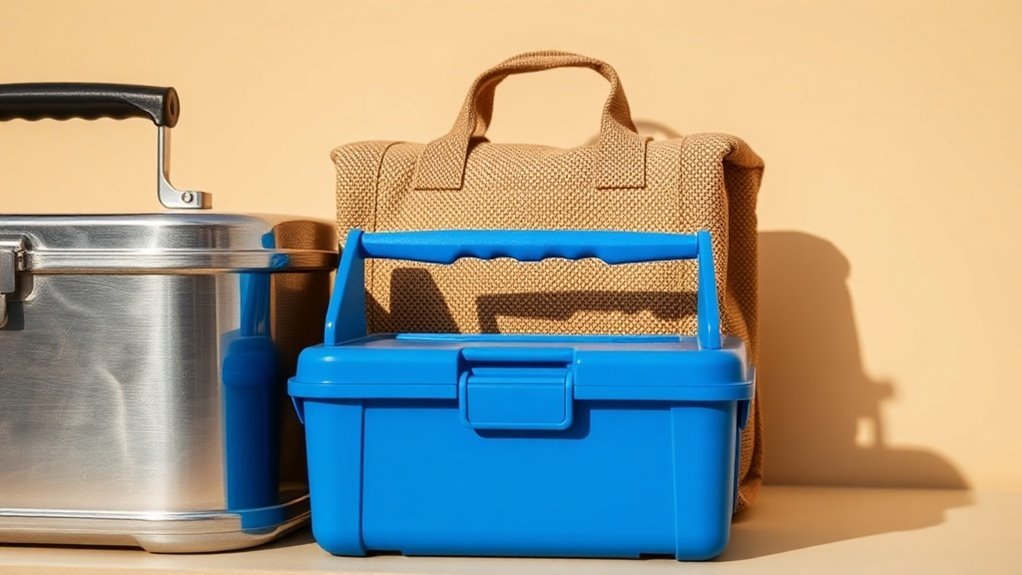
When it comes to toolboxes, plastic options offer several great advantages.
They’re lightweight and easy to carry, making them perfect for on-the-go projects.
Plus, their weather-resistant design and cost-effective nature guarantee you’re making a smart choice for your toolkit.
Lightweight and Portable
Although you might prioritize durability in tool storage, plastic toolboxes offer remarkable lightweight and portable advantages that can’t be overlooked.
We all know how challenging it can be to lug heavy metal toolboxes around, especially during weekend projects or repairs. With plastic toolboxes, you get easy transport without sacrificing too much strength.
Their lightweight design allows you to carry them with one hand or toss them in your vehicle without breaking a sweat. Plus, many plastic models come with ergonomic handles, enhancing comfort during transport.
If you frequently need to move your tools from site to site, choosing a plastic toolbox means keeping your load light. You’ll appreciate the convenience and ease they bring to your DIY endeavors.
Weather Resistant Design
While portability is a strong suit of plastic toolboxes, their weather-resistant design is another compelling reason to take into account them for your tool storage needs. These toolboxes protect your tools from moisture, dust, and harsh elements, prolonging their lifespan and ensuring reliability in any working environment.
Here’s a quick comparison of key factors that highlight their benefits:
| Feature | Plastic Toolboxes |
|---|---|
| Moisture Resistance | Yes |
| Rust Resistance | Yes |
| UV Protection | Yes |
| Ease of Cleaning | Very Easy |
Choosing a weather-resistant plastic toolbox means you’ll safeguard your tools effectively, allowing you to work confidently, rain or shine. They’re ideal for anyone needing durable, reliable storage solutions for varying conditions.
Cost-Effective Option
Considering budget constraints is essential for anyone looking to invest in tools and storage solutions, and plastic toolboxes offer a cost-effective option that doesn’t compromise on quality.
These toolboxes typically come with lower price tags compared to metal or fabric options, making them accessible for DIY enthusiasts and professionals alike.
Lightweight and easy to carry, plastic toolboxes allow for convenient transport, whether you’re moving between job sites or storing them at home.
Plus, their durable construction averts the need for frequent replacements, saving you money in the long run.
With various sizes and designs available, you can find a plastic toolbox that suits your needs without breaking the bank, ensuring you get both functionality and affordability in one package.
Drawbacks of Plastic Toolboxes
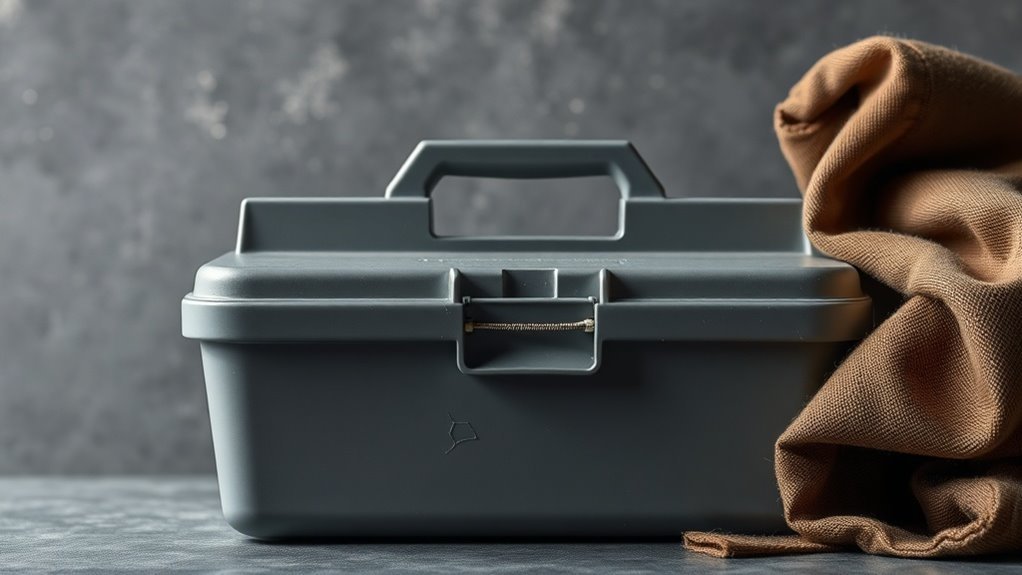
While plastic toolboxes offer convenience, they come with some notable drawbacks.
You might find that their durability isn’t as strong as metal options, especially under heavy use.
Additionally, they often have weight limitations that can restrict how many tools you can safely store.
Durability Concerns
When it comes to toolboxes, plastic options seem appealing due to their lightweight nature and often lower price tags.
However, durability concerns can quickly come into play. You might find that plastic toolboxes can crack or warp under extreme temperatures, making them less reliable in harsh environments.
Over time, exposure to UV rays can lead to fading and brittleness, reducing their lifespan considerably. If you drop a plastic toolbox, it may not withstand the impact like metal options would.
Even rough handling during transport can result in dents or broken latches.
While they’re great for casual use, if you’re tackling tougher jobs or need a toolbox that can endure various conditions, plastic may not be your best bet.
Weight Limitations
Plastic toolboxes may seem like a practical choice, but their weight limitations can pose significant drawbacks. Unlike metal counterparts, these toolboxes just can’t handle heavy loads effectively.
When you’re trying to store bulky tools or materials, you might find yourself exceeding the weight capacity, leading to potential breakage or failure. This isn’t just inconvenient; it can also be dangerous if you’re relying on them while working at heights or in unstable environments.
Plus, frequent weight-related stress can cause wear and tear, reducing your toolbox’s overall lifespan. If you need something durable that can carry a heavier load without risk, you might want to reconsider and opt for a more robust option, like a metal toolbox, instead.
Advantages of Metal Toolboxes
Metal toolboxes offer several advantages that make them a preferred choice for many DIY enthusiasts and professionals alike. Their durability guarantees they withstand harsh conditions, protecting your tools long-term. Additionally, metal’s inherent resistance to certain chemicals can last through various projects without wearing down.
Here’s a brief comparison of some key benefits:
| Advantage | Description |
|---|---|
| Durability | Metal toolboxes are built to last. |
| Weather Resistance | They handle rain and moisture better. |
| Security | Metal locks provide enhanced protection. |
Moreover, adopting proper tool storage techniques can further enhance the safety and longevity of your metal toolbox.
Disadvantages of Metal Toolboxes
While metal toolboxes have their merits, they aren’t without drawbacks. One major issue is their weight; they can be cumbersome and hard to transport, especially when filled with tools.
Metal toolboxes offer benefits but can be heavy and cumbersome, particularly when loaded with tools.
Additionally, metal toolboxes are prone to rust and corrosion, particularly if they get wet or are exposed to moisture over time. This may compromise the integrity of your tools inside.
Also, if you drop or bump a metal toolbox, it can dent or scratch easily, showing wear quickly. Finally, they tend to be pricier than their plastic counterparts, which can be a consideration if you’re on a budget.
All in all, these factors may lead you to rethink choosing a metal toolbox for your needs.
Features of Fabric Toolboxes
When it comes to fabric toolboxes, you’ll appreciate their lightweight and portable design, making them easy to carry wherever you need.
They offer clever storage solutions that maximize space and keep your tools organized.
Plus, with versatile compartment options, you can customize the layout to fit your specific needs.
Lightweight and Portable
Fabric toolboxes stand out for their lightweight and portable design, making them ideal for anyone on the go. You’ll appreciate how easy they’re to carry, whether you’re heading to a job site, a DIY project, or just need quick access to your tools at home.
Many fabric toolboxes come with comfortable handles or shoulder straps, allowing you to transport them effortlessly. They can easily fit in your car trunk or be carried inside with minimal effort. Since they’re so lightweight, you won’t strain yourself while lugging them around.
This feature is especially useful when you need a hands-free option, offering flexibility without sacrificing functionality. With fabric toolboxes, you can move your essentials securely and comfortably wherever you need them.
Easy Storage Solutions
One of the standout features of fabric toolboxes is their innovative storage solutions. You’ll appreciate how they adapt to your needs, often featuring multiple pockets and pouches that allow you to keep tools organized and accessible.
Unlike traditional rigid boxes, fabric options can easily compress or expand, making it simple to maximize space when you’re not using them. You can also toss them in a corner or on a shelf without worrying about their shape.
These toolboxes often come with adjustable straps, helping you secure your items during transport. When you need quick access, just unzip and grab what you need.
This flexibility makes fabric toolboxes a top choice for DIY enthusiasts and professionals alike.
Versatile Compartment Options
The storage solutions in fabric toolboxes are complemented by their versatile compartment options, which cater to various tool types and sizes.
You’ll find pockets in multiple shapes and depths, allowing you to organize everything from small screws to larger power tools. The adjustable dividers can be rearranged to fit your needs, making it easy to switch between different projects.
Many fabric toolboxes also feature external pockets for quick access to frequently used items. Lightweight yet durable, these toolboxes can easily adapt to your workspace, whether at home or on a job site.
With such flexible compartment options, you can confidently store your tools without worrying about clutter or damage, ensuring you’ll always find exactly what you need when you need it.
Pros and Cons of Fabric Toolboxes
While you might appreciate the lightweight nature of fabric toolboxes, it’s essential to weigh their pros and cons.
On the positive side, fabric toolboxes are often flexible and easy to carry, making them ideal for those who need mobility. They can also offer a variety of pockets and compartments for organizing tools efficiently. Additionally, they generally come at a more affordable price point compared to metal or plastic options.
On the downside, fabric toolboxes can be less durable than other materials. They may suffer from wear and tear more quickly and aren’t usually waterproof, which might be a concern if you’re working in wet conditions.
Comparing Durability Across Materials
When it comes to durability, fabric toolboxes often fall short compared to their metal or plastic counterparts.
Metal toolboxes are tough, able to withstand impacts and resist rust, making them ideal for heavy-duty use. Plastic toolboxes, while generally lighter, also offer good resistance to moisture and dents, making them a solid choice for various environments.
In contrast, fabric toolboxes can tear or wear out over time, especially under heavy loads or rough handling. They might suit lighter tasks and organization, but when durability is key, you’ll want to take into account metal or plastic options. Additionally, climate conditions can significantly influence the effectiveness of different toolbox materials in protecting your tools from damage.
Weight and Portability Considerations
Choosing the right toolbox often hinges on how easy it’s to transport, especially if you’ll be moving tools frequently. Weight and portability are key factors to evaluate, as they’ll impact how comfortably you can carry your gear.
- Plastic Toolboxes: Lightweight and easy to handle, perfect for quick jobs.
- Metal Toolboxes: Durable but can be heavy; great for long-term storage.
- Fabric Toolboxes: Super lightweight and flexible, ideal for carrying essentials.
Depending on your needs, find a balance between capacity and how much you’re willing to carry. A well-chosen toolbox can save your back while ensuring your tools are always within reach.
Don’t overlook the importance of weight when making your selection!
Price Range and Value for Money
As you evaluate toolboxes, it’s essential to take into account both the price range and the value for money they offer.
Generally, plastic toolboxes are the most budget-friendly, making them a great choice if you’re on a tight budget. However, they mightn’t withstand heavy use.
Metal toolboxes, while pricier, provide durability and longevity, which can translate to better value over time.
Fabric toolboxes often fall in the middle; they’re affordable but may lack the sturdiness of both plastic and metal options.
When reviewing value, consider the warranty and user reviews too—it’s wise to invest in a quality toolbox that’ll withstand your needs.
Ultimately, balance your budget with the longevity and utility of the toolbox for the best deal.
Questions
How Do I Choose the Right Size Toolbox for My Needs?
To choose the right size toolbox, think about what tools you have and their sizes. Consider your storage space and how portable you need it to be. Balance capacity with convenience to suit your needs.
What Types of Tools Fit Best in Each Toolbox Material?
For plastic toolboxes, think lightweight hand tools. For metal, consider heavier items like power tools. For fabric, opt for smaller tools or accessories. Each material suits specific needs, so choose based on your tools’ requirements!
Can I Customize or Personalize My Toolbox?
Yes, you can customize or personalize your toolbox! Many options exist, like adding stickers, custom paint, or even engraving your name. Personal touches can make your toolbox uniquely yours and reflect your style and personality.
How Can I Maintain and Clean My Toolbox Effectively?
To maintain and clean your toolbox, regularly wipe it down with a damp cloth and mild soap. For tough stains, use a soft brush. Avoid harsh chemicals that could damage the material or finish.
Are There Eco-Friendly Options for Toolboxes Available?
Yes, there’re eco-friendly toolbox options available. Consider using toolboxes made from recycled materials, biodegradable plastics, or sustainable fabrics. These choices can help reduce your environmental impact while still providing durability and functionality for your tools.
Conclusion
In the end, choosing a toolbox’s like picking a tool itself—it’s gotta fit your needs. If you’ve ever tried to use a flimsy screwdriver, you know the frustration of an inadequate choice. Just like that, the right toolbox can make all the difference in your projects. Whether you lean towards plastic, metal, or fabric, consider durability, weight, and value to find what truly works for you. Your next project’s success might just depend on it!

